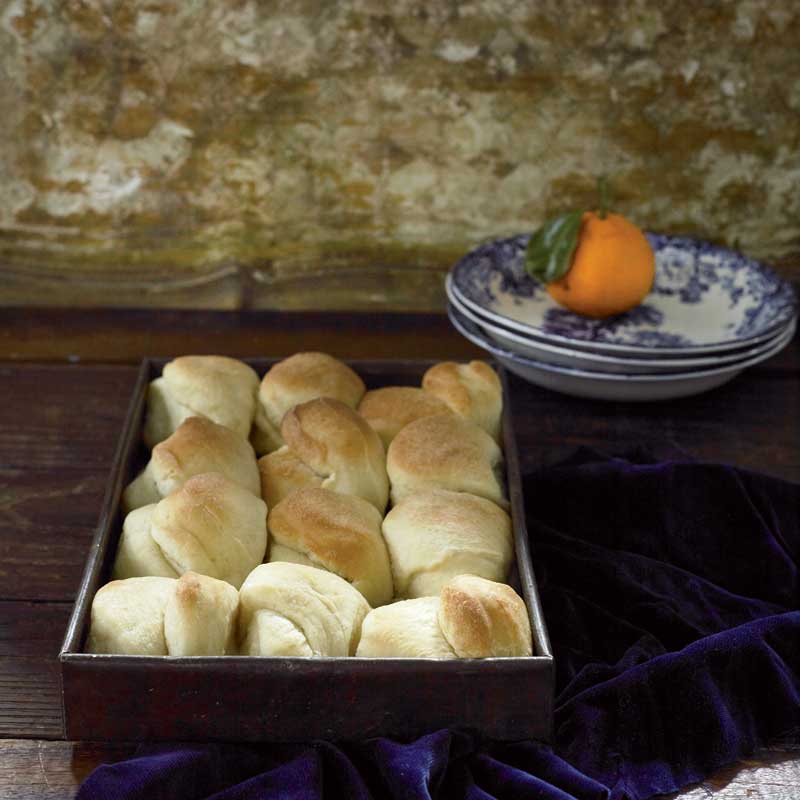New England Breads
A collection of favorite New England breads, including Anadama, Parker House Rolls, Whole Wheat, and No-Knead. A loaf of bread, a glass of wine … yes, satisfying things. But more satisfying is when you let life slow down (just a little bit) and you make the bread yourself. The overall time from start to finish […]

Parker House Rolls
Photo Credit : Hornick/RivlinA collection of favorite New England breads, including Anadama, Parker House Rolls, Whole Wheat, and No-Knead.
A loaf of bread, a glass of wine … yes, satisfying things. But more satisfying is when you let life slow down (just a little bit) and you make the bread yourself. The overall time from start to finish can be days, but the actual “hands-on” is minimal. None of these recipes is difficult, even for first-time bakers.

Photo Credit : Hornick/Rivlin

Photo Credit : Hornick/Rivlin
Most culinary historians concur that leavened bread was likely “invented” (or more likely resulted from a kitchen accident) around 3000 b.c. by the Egyptians. (Unleavened breads had been around since at least 8000 b.c.) Bread is ancient and elemental, which is perhaps part of the reason for the particular fulfillment it gives us–like raising tomatoes from seed. A baker brings together flour, water, and yeast and combines them in a centuries-old process that makes magic: Water activates the yeast and lets the flour’s protein form strands of gluten; kneading warms and stretches the gluten strands to create the loaf’s texture and shape; the yeast feeds on the flour’s carbohydrates to produce the carbon dioxide that makes the dough rise; and oven baking gives the yeast one last boost.
For many of these recipes, the amounts of flour and water you’ll use vary. Often depending on the weather, the dough may need more of one or the other ingredient. The more bread you make, the more you’ll get a feel for when the dough is just right. Baking bread is a good thing to do any time of the year, but somehow these warming spring days are when I crave it most.

Photo Credit : Hornick/Rivlin

Photo Credit : Hornick/Rivlin
GUIDE TO YEAST
Yeast is everywhere. It’s a single-celled organism–actually a type of fungus, a nongreen plant. We’ve adapted one type of yeast to serve as a catalyst in the process of fermentation, essential to bread baking. Yeast activated by water feeds on the carbohydrates in flour and expels carbon dioxide, which fills up and expands the pockets in between strands of the flour’s protein (also known as gluten, which forms when you add water to flour).
Most yeasts you’ll find in the grocery store are either “regular active” or instant (also labeled rapid-rise, fast-rising, or bread machine yeast). You may use either one for baking. Instant rises faster, so if you’re in a rush, opt for that–but why rush when making bread? Savor every moment of this satisfying activity, creating your own flavorful, fragrant home-baked loaves from scratch.
I usually use all-purpose flour (King Arthur brand, specifically), but in the baking aisle of your local market you’ll likely find bread flour, self-rising flour, whole wheat and rye flours, pastry and cake flours, and so on. Most of the difference among these ingredients lies in the amount of protein in the wheat before it was ground. For details on each type, see the list below.
All-Purpose Flour. A combination of high-protein bread flour and low-protein cake flour. The bread flour is milled from a variety of “hard” wheat full of protein that you’ll call into action by adding water.
Whole-Wheat Flour. Milled from the entire wheat berry (bran and germ in addition to the endosperm), with a deeper, nuttier flavor.
Bread Flour. High-protein flour made with as much as 99.9 percent hard wheat flour, with a bit of malted-barley powder added to encourage yeast activity, which helps the bread rise.
Self-Rising Flour. Contains a bit of baking powder for an added boost.
Cake Flour. High in starch and finely milled from “soft” wheat (low protein content), which means that it contains less protein. You end up with a tender crumb, great for cakes. Most cakes get their leavening from eggs and baking powder (or baking soda), not yeast.
Pastry Flour. Similar to cake flour, but with a bit more protein, for a flaky crust.
NEW ENGLAND BREAD RECIPES

